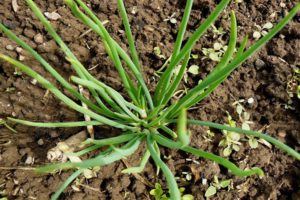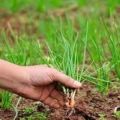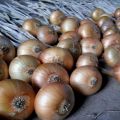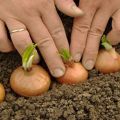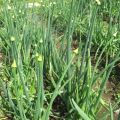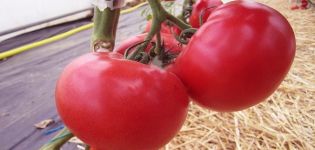Planting, growing and caring for onion sets in the open field, its diseases and combating them
Growing onions requires a lot of effort from the summer resident, the organization of proper care for the plantings. Therefore, many gardeners consider this plant to be capricious. The most convenient option is planting and caring for onion sets in the open field. Sevok - small bulbs with a diameter of 1.5-2.5 centimeters, growing in the first year of sowing seeds. Some knowledge about soil preparation, planting material, caring for seedlings planted in open ground will help to facilitate the process of growing a plant.
Technology of growing onion sets
Onions are a biennial plant that gives a bulb in the first year, and in the second - seeds, called nigella for their color. To get onion sets, fresh seeds need to be sown in spring. Before planting, nigella is soaked in water for 2-3 hours, and then wrapped in a damp cloth for a couple of days. After some seeds begin to germinate, the seed is dried to a loose state.
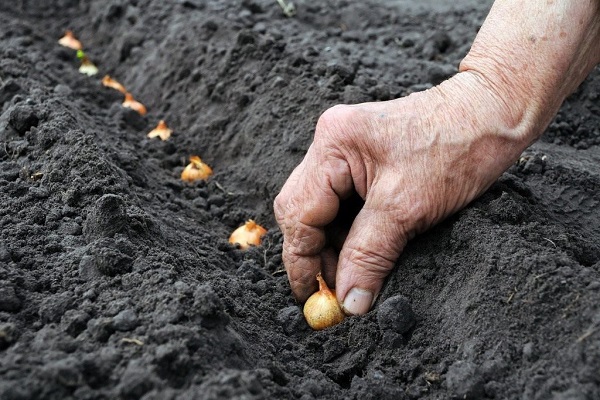
Growing onion sets from seeds begins with soil preparation. The first step is to form grooves with a depth of 2 centimeters. The distance between the furrows is 10 centimeters. Seed material is sown tightly, and then the grooves are mulched with peat or humus.
To obtain large seeding, you will need to regularly thin out their seedlings. Growing and caring for onion sets requires fertilization. The plant culture must be fed with a liquid mullein at a rate of 10 liters of the product per 1 square meter. A composition of 1 liter of fertilizer and 10 liters of water is being prepared.
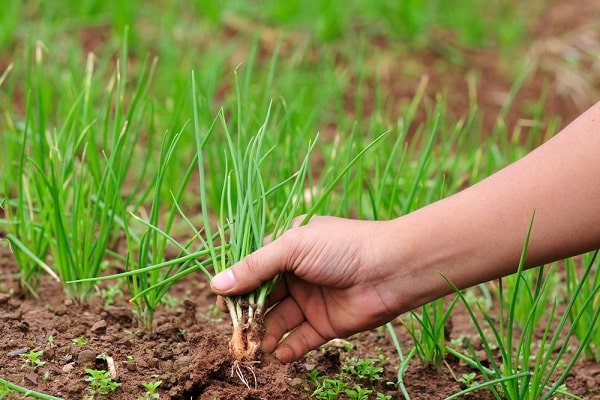
You can remove the sevok after the feather wilts and falls, and the bulbous necks acquire a thin and soft structure. The harvested crop is dried, cleaned of tops, sorted by size. All but the largest bulbs are placed in a 6-10 cm layer in small boxes or bags made of fabric, 2-3 kg each. You can store them at a temperature of 16-18 degrees.
Preparing the soil for planting
Before planting onions in open ground, you must fully prepare the soil. The place where the planting material will be planted should be located in an illuminated summer cottage. The best place is considered to be soil with deep deposits of groundwater. This arrangement will avoid over-watering the plant, which often leads to the wilting of the crop.

They begin to prepare the soil in winter. Before the onset of cold weather, the earth is dug at a depth of 16–20 centimeters. Fertilizers are applied to the beds. The best option is manure or peat compost.You need to fertilize the soil before the onset of cold weather; this should not be done before planting seedlings.
You should also assess the acidity of the soil, since onions do not grow in an acidic environment. To reduce acidity, chalk and wood ash are introduced into the ground. Lime and fertilizers should not be applied at the same time, otherwise the level of soil fertility will decrease: nitrogen is eliminated from manure and peat, which is necessary for the formation of full-fledged plant crops. Grown onions in the ground prepared according to the presented scheme are distinguished by large bulbs.
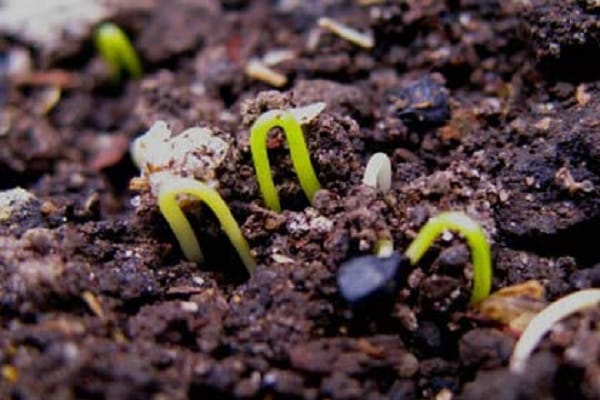
What is the best time to plant sevok?
The last days of April are considered the best time for planting sets. Such terms are due to the fact that most varieties of onion sets are resistant to cold. If you plant later, the topsoil will quickly dry out and lose the accumulated moisture. Such processes adversely affect the rooting of the bulbs, which slows down the process of emergence, contributes to incomplete ripening of the culture. For disembarkation, the air temperature should be within 12-14 degrees.
In the Ural and Siberian territories, the landing should begin in early May - from about 5-10. At this time, the temperature of the soil reaches 7 degrees.
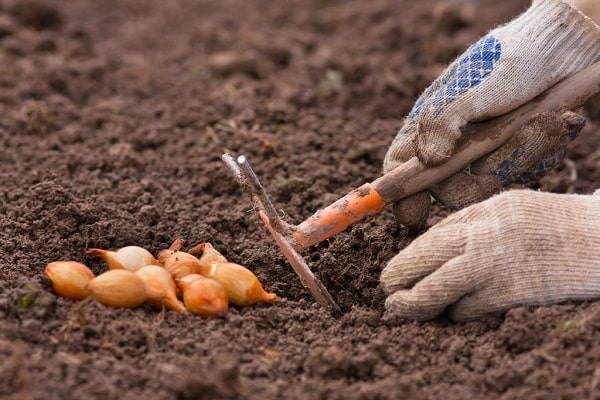
Also, some summer residents plant seed sets before winter. They do this in the second half of October.
How to plant onion sets?
Before planting onion sets, it is necessary to properly prepare the seed. Preparation of any varieties of onion sets consists in observing the following instructions:

- To increase growth and yield, the seedlings need to be warmed up before planting. The material is spread over a flat surface and left for 2-3 weeks at a temperature of 18-20 degrees. Then the onion is warmed up at a temperature of 38-40 degrees for 7-10 hours.
- Then disinfection and stimulation of the growth of planting material is done. Mineral fertilizers are used for stimulation. Before processing, the seedlings are washed with water, alternating between warm and cold temperatures. Then the bulbs are immersed in mineral fertilizers for 5–7 hours. Then disinfection is carried out using potassium permanganate or copper sulfate.
- There is also a popular recipe for the preparation of planting material. Onions are dried at a temperature of 20 degrees for 1 week. Then the sowing is washed in a saline solution, and then kept in it for 2-3 hours. Onions are washed with running water, immersed in a weak solution of potassium permanganate for disinfection for 2 hours. Then the seed is washed with water, dried until the top layer dries.
After the measures taken, you can plant the head in open ground.

Onion planting scheme
Ridges should be organized in place of tomatoes, eggplants, pumpkins, potatoes or cereals. It is better not to plant seedlings at the place where the garlic is grown, since the soil in this place is greatly depleted.
Planting should begin by clearing the site of debris. You also need to fertilize the soil with the following minerals:
- superphosphate: 6 grams of fertilizer is applied per 1 square meter;
- urea: 1 gram of substance is taken per 1 square meter;
- potassium chloride: 2 grams of fertilizer are needed per square meter.
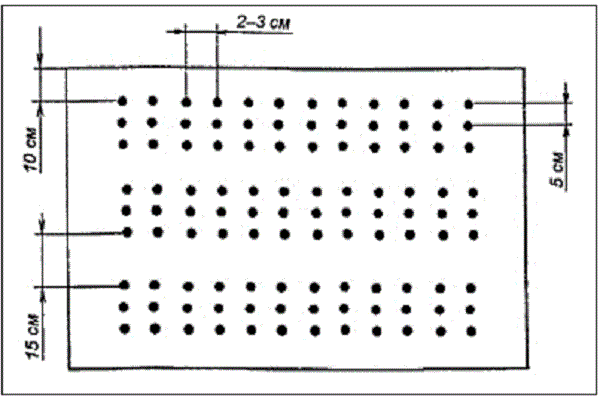
Substances are scattered on the ground, and then the soil is cultivated.
7 days before planting the culture, it is necessary to disinfect the soil with a solution prepared from 1 tablespoon of copper sulfate and 1 bucket of water. Then you can start planting. Growing onions from sets is carried out in several ways. The most popular of them are plantings before winter and spring. The planting method is identical to the spring one, except that with the cold planting is covered with mulch.

Planting onions in spring
1 week before transplanting, the soil should be dug up and watered with a solution of copper sulfate and water.Further, when landing, you should follow the instructions:
- Onions that are 1 centimeter in diameter should be planted 5 centimeters apart. If the bulbs are 1.5 centimeters in diameter, they should be planted 8 centimeters apart. With a diameter of 2 centimeters, a gap of 10 centimeters must be observed.
- A distance of 20-25 centimeters should remain between the beds, under this condition, the root system of the onion will actively develop.
- Sevok is planted to a depth of five centimeters.
- The tops of the bulbs are sprinkled with mulch in the form of sawdust, straw. The thickness of the mulch should be within 3-4 centimeters.

If the summer resident has a walk-behind tractor, a gap of 60-72 centimeters should be made between the rows. If the sevok is planted according to the specified instructions, it will be possible to harvest in August.
Care
Onion care implies compliance with the rules of watering, feeding, as well as protecting against pests and diseases.
Sprouted sets are often harmed by onion flies. You can determine the presence of the disease by yellowing feathers. If such signs appear, the planting should be discarded, since its bulb will no longer be suitable for human consumption. Because of this, every summer resident must process the planted sevok with special solutions that protect onions from pests and diseases. Among folk remedies, a solution of potassium permanganate and tobacco ash is especially popular.

Also, one of the aspects of planting care is the timely loosening of the soil, which contributes to the enrichment of the root system with oxygen. If this rule is neglected, various pathologies can attack the bow.
If the onion is not killed by pests, you need to pay attention to the neighboring plantings. Garlic and carrots are destructive neighbors for onions. If tomatoes, cucumbers or cabbage are planted next to the seed plant, the plantings are not affected by pests.
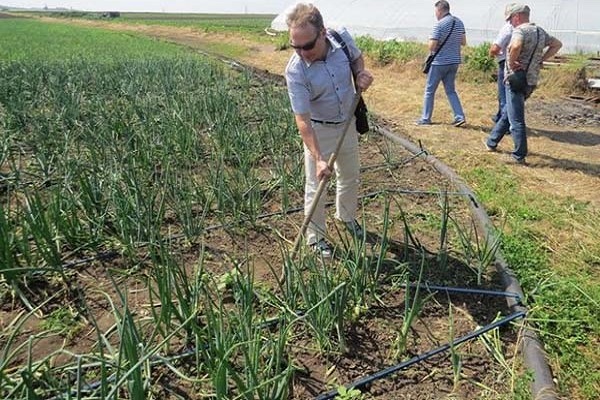
Top dressing sevka
The first top dressing should be applied 2–3 weeks after planting. During this period, the onion begins to actively form leaves. Urea is used as a fertilizer: 25 grams of the product is dissolved in 10 liters of water. The specified amount of liquid is used to treat 10-12 running meters. Also at this time, you can feed the plants with nitrophos, nitroammophos.
For irrigation of 1 square meter, 25 grams of the product and 10 liters of water are used. After fertilization, the bulbous arrows must be thinned out. After applying top dressing, the plant should be watered from a fine-mesh watering can, washing off the remnants of substances from the greenery.
The next top dressing is carried out with the help of phosphorus-potassium fertilizers. It is done 3 weeks after the first. To do this, you can use 25 grams of superphosphate and 10 grams of potassium salt. You can also use 40 grams of nitroammophoska dissolved in 10 liters of water.

If the plants are weak, a third feeding can be done. For this, phosphorus-potassium compounds are used. The dosage of the drug corresponds to the second feeding.
How to water onions?
In order for the onion to fully form, it requires a small amount of water, but constantly moistened soil in the first month after germination, as well as during the development of the bulb. At first, watering is carried out once every 2 weeks; in dry weather, the number of waterings doubles. With an increase in the amount of watering, it is necessary to loosen the soil.
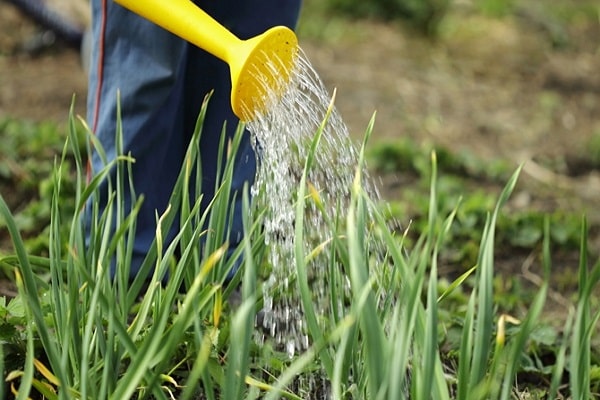
In order for the plant to form a good turnip, in the first month the soil should be watered to a 10-centimeter layer. Gradually, by the phase of development of the bulbs, this layer increases to 25 centimeters. In the last month of cultivation of any of the varieties of onion sets, watering stops. It is replaced by regular loosening of the soil, freeing the upper bulbous part from the ground.
Sevka storage and cleaning
Once the bulb has turned yellow and has stopped forming feathers, you can start harvesting. Most often, cleaning takes place in mid-August or early September. The crop is washed, cleaned of husks, dry feathers, roots.
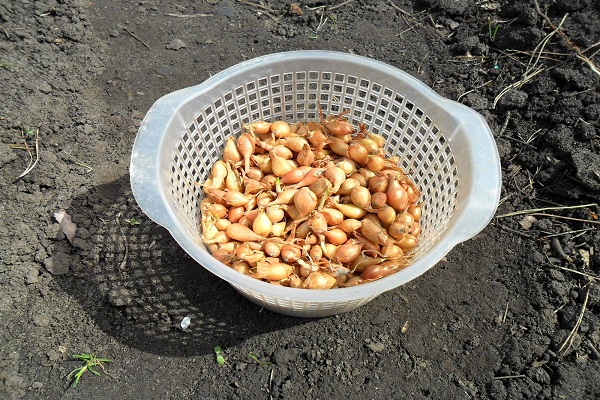
Then the onions are dried in a ventilated area for several weeks. After dry scales appear on the bulb, it can be stored.
The grown bulbs from the set should be stored in a cool dark place. If the onion was grown taking into account all the recommendations presented above, any of its varieties and names will have a long shelf life.


